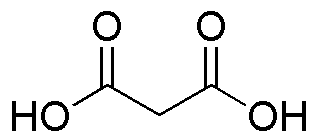Malonic acid anhydrous is widely utilized in research focused on:
- Synthesis of Pharmaceuticals: It serves as a key building block in the synthesis of various pharmaceutical compounds, enhancing the efficiency of drug development.
- Biochemical Research: This compound is used in metabolic studies and enzyme research, helping scientists understand biochemical pathways and enzyme functions.
- Polymer Production: Malonic acid anhydrous is employed in the production of biodegradable polymers, contributing to environmentally friendly materials in the plastics industry.
- Food Industry: It acts as a food additive, particularly in flavor enhancement and preservation, ensuring food safety and quality.
- Cosmetic Formulations: The compound is used in cosmetics for its moisturizing properties, providing benefits in skin care products.
General Information
Properties
Safety and Regulations
Applications
Malonic acid anhydrous is widely utilized in research focused on:
- Synthesis of Pharmaceuticals: It serves as a key building block in the synthesis of various pharmaceutical compounds, enhancing the efficiency of drug development.
- Biochemical Research: This compound is used in metabolic studies and enzyme research, helping scientists understand biochemical pathways and enzyme functions.
- Polymer Production: Malonic acid anhydrous is employed in the production of biodegradable polymers, contributing to environmentally friendly materials in the plastics industry.
- Food Industry: It acts as a food additive, particularly in flavor enhancement and preservation, ensuring food safety and quality.
- Cosmetic Formulations: The compound is used in cosmetics for its moisturizing properties, providing benefits in skin care products.
Documents
Safety Data Sheets (SDS)
The SDS provides comprehensive safety information on handling, storage, and disposal of the product.
Product Specification (PS)
The PS provides a comprehensive breakdown of the product’s properties, including chemical composition, physical state, purity, and storage requirements. It also details acceptable quality ranges and the product's intended applications.
Certificates of Analysis (COA)
Search for Certificates of Analysis (COA) by entering the products Lot Number. Lot and Batch Numbers can be found on a product’s label following the words ‘Lot’ or ‘Batch’.
*Catalog Number
*Lot Number
Certificates Of Origin (COO)
This COO confirms the country where the product was manufactured, and also details the materials and components used in it and whether it is derived from natural, synthetic, or other specific sources. This certificate may be required for customs, trade, and regulatory compliance.
*Catalog Number
*Lot Number
Safety Data Sheets (SDS)
The SDS provides comprehensive safety information on handling, storage, and disposal of the product.
DownloadProduct Specification (PS)
The PS provides a comprehensive breakdown of the product’s properties, including chemical composition, physical state, purity, and storage requirements. It also details acceptable quality ranges and the product's intended applications.
DownloadCertificates of Analysis (COA)
Search for Certificates of Analysis (COA) by entering the products Lot Number. Lot and Batch Numbers can be found on a product’s label following the words ‘Lot’ or ‘Batch’.
*Catalog Number
*Lot Number
Certificates Of Origin (COO)
This COO confirms the country where the product was manufactured, and also details the materials and components used in it and whether it is derived from natural, synthetic, or other specific sources. This certificate may be required for customs, trade, and regulatory compliance.

